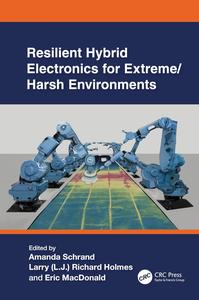|
|

Free Download Resilient Hybrid Electronics for Extreme/Harsh Environments
English | 2024 | ISBN: 036768764X | 187 Pages | PDF (True) | 16 MB
The main topics covered in this book include some of the most promising materials, methods, and the ability to integrate printed materials with commercial components to provide the basis for the next generation of electronics that are dubbed "survivable" in environments with high g‑orces, corrosion, vibration, and large temperature fluctuations. A wide variety of materials are discussed that contribute to robust hybrid electronics, including printable conductive composite inks, ceramics and ceramic matrix composites, polymer‑erived ceramics, thin metal films, elastomers, solders and epoxies, to name a few. Collectively, these materials and associated components are used to construct conductive traces, interconnects, antennas, pressure sensors, temperature sensors, power inducting devices, strain sensors and gauges, soft actuators, supercapacitors, piezo ionic elements, resistors, waveguides, filters, electrodes, batteries, various detectors, monitoring devices, transducers, and RF systems and graded dielectric, or graded index (GRIN) structures. New designs that incorporate the electronics as embedded materials into channels, slots and other methods to protect the electronics from the extreme elements of the operational environment are also envisioned to increase their survivability while remaining cognizant of the required frequency of replacement, reapplication and integration of power sources. Lastly, the ability of printer manufacturers, software providers and users to work together to build multi‑axis, multi‑material and commercial‑off‑the‑shelf (COTS) integration into user‑friendly systems will be a great advancement for the field of printed electronics.
Links are Interchangeable - Single Extraction |
|